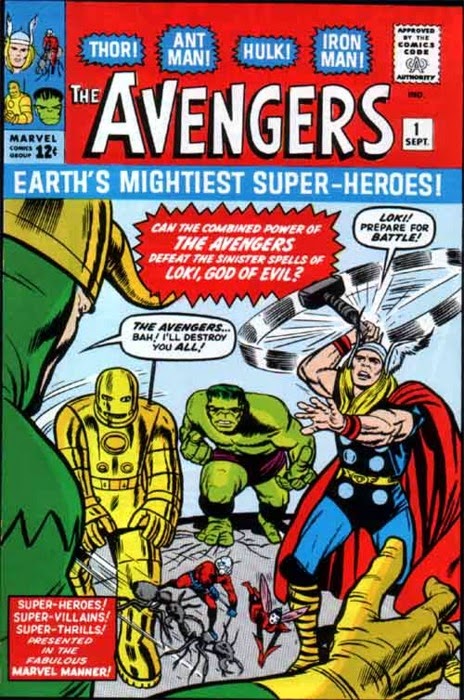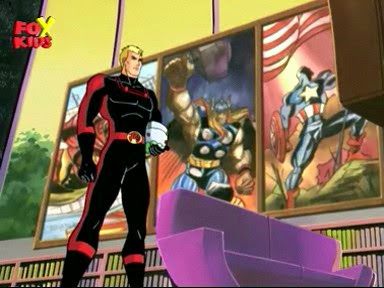The Avengers made their debut in Marvel Comics’ Avengers #1 (September, 1963), written by Stan Lee and drawn by Jack Kirby. The book primarily
consisted of characters previously introduced in Marvel’s various books since the
company’s revitalization with Fantastic Four #1 in 1961.
The evil Asgardian
god of mischief, Loki (Journey Into Mystery #85, 1962), sought
revenge against his half-brother, the thunder god Thor (Journey Into Mystery #83, 1962), for
his constant interference in Loki’s schemes. Part of his plan involved Loki
pitting Thor against the Hulk (The Incredible Hulk vol. 1 #1, 1962),
the alter-ego of scientist Bruce Banner who, after he was exposed to gamma
radiation, emerged whenever Bruce got angry. However, Loki’s
scheme backfired when he inadvertently involved billionaire inventor Tony
Stark, who created a suit of armor to become Iron Man (Tales of
Suspense #39, 1963), scientist Henry
Pym, whose matter-shrinking Pym Particles and ant communicating helmet let him
become Ant-Man (Tales to Astonish
#27, 1962), and heiress Janet Van Dyne, Henry’s
girlfriend who sprouted synthetic wings when she used Pym Particles to shrink
as the Wasp (Tales
to Astonish #44, 1963). Together with
the Hulk, the heroes banded together and defeated Loki. Deciding they made a
great team, the Avengers were born.
In
1997, FOX was
experiencing a decline in its ratings as ABC, Kids' WB, Nickelodeon and
the Disney Channel were delivering a broad slate of programs and
aggressively marketing them to their audiences. Roland
Poindexter, Vice President and Head of
Programming at Fox
Kids, recognized that his network had become
known for its action-adventure shows—particularly based on Marvel properties—and
approached X-Men:
The Animated Series writers Robert N. Skir and Marty Isenberg to develop a proposal for an Avengers series. They produced
a detailed 13-episode story arc in their series bible, but Fox became more
interested in pursuing a Captain
America solo series.
Cap, first debuting during Marvel’s days as
Timely in 1941’s Captain
America Comics #1, was scrawny Steve
Rogers who was given a Super Soldier formula to turn him into a soldier at the
peak of human development. However, like many of the superheroes at the time,
his popularity waned following the end of World War II, and he was removed from his own book with issue #73 (the book ran as a horror
anthology title for two more issues). Timely
attempted to revitalize the character in the 1950s by pitting him
against communists, but that return was
short-lived and his book cancelled again. He disappeared from publication until
Lee and Kirby decided to revive the character in Avengers #4 in 1964; his absence explained by his being frozen in
suspended animation after World War II, found by the Avengers, and thawed out
in the then-present day (the one who fought communists was later explained as
being other men tasked with taking up the mantle in Steve’s absence).
 |
| Captain America makes an appearance. |
Neither show went into development as Marvel
had gone into bankruptcy during the comics
bust of the 1990s. When Marvel’s financial
troubles stabilized in 1998, Poindexter revisited the idea and brought in X-Men series
story editor Eric
Lewald and his wife Julia to
do it. In 1999, Fox green-lit the series and Ron Myrick was hired to oversee the show’s visual development.
It was decided to leave out the “big three” Avengers--Captain America, Iron Man
and Thor--in order recapture the popularity of the team when those heroes
weren’t members in the comics, and to focus on a line-up of more flawed
characters for greater story potential without their risking being overshadowed
by the bigger names. The trio, however, did make an appearance at the end of
the opening sequence throughout the show’s run.
 |
| Hawkeye, Tigra, Wasp, Ant-Man, Wonder Man, Scarlet Witch, Falcon and the Vision. |
The team’s line-up was loosely borrowed from
the Avengers spin-off West Coast Avengers (later renamed Avengers
West Coast). Founding Avenger Ant-Man (Rod Wilson) was made the leader of
the team, and was joined by fellow founder Wasp (Linda Ballentyne). Filling out
the roster was Captain America’s former partner, Sam Wilson, aka Falcon (Martin
Roach), who could fly via a special harness and communicate with birds—in
particular his falcon, Redwing; Clint Barton, aka Hawkeye (Tony Daniels), a
former criminal and master bowman; Wanda Maximoff, aka the mutant Scarlet Witch
(Stavroula Logothettis), with hex-casting abilities that she activated by
saying “Winds of destiny, change!”; Greer Nelson, aka Tigra (Lenore Zann), an
athlete who underwent genetic treatments to give her an edge that ended up
transforming her into a tiger woman (an origin different from the comics); the
synthezoid android The Vision (Ron Ruben), who was created by the evil robot Ultron (John Stocker) to destroy the Avengers and turned to their side after
being given Wonder Man’s memories; and Simon Williams, aka Wonder Man (Hamish
McEwan), whose ionic powers gave him super strength, flight,
near-invulnerability and energy blasts, and who spent half the series in a coma
after being attacked by Vision (echoing Beast’s being
sidelined for the first season of X-Men). Supporting the team was Edwin
Jarvis (Graham Harley), the team’s butler who maintained their headquarters.
Captain America (Dan
Chameroy) and Iron Man (Francis Diakowsky) each made a guest appearance on the show, but Thor never
appeared outside of his title sequence cameo. The series’ main focus was the
team trying to live up the legacy established by the big three, particularly
Ant-Man who, as team leader, was following in Cap’s very large footsteps.
A major difference from the source material was
the introduction of special armor for Ant-Man, Wasp, Falcon and Hawkeye, which
they donned in stock Super
Sentai-inspired transformation sequences.
Although no explanation was given on the show itself for the armor, the tie-in
comic series attempted to do so by setting
its first two issues before the premiere. The story saw the Avengers laid low
by an early version of Ultron, and as a result Pym developed their armor to
give them more protection and strength in battle based on the armor he created
for himself after his legs were broken by Dragon Man. The world of the show was also set 25 years in the
future, accounting for their armor, futuristic technology, and how some of the
settings looked, in an attempt to try and emulate Batman Beyond and
duplicate its success.
Avengers:
United They Stand debuted as part of Fox
Kids on October 30th, 1999, replacing Spider-Man: Unlimited. The series was written by Michael Edens, John
Loy, Len Uhley, Brooks Wachtel, Len
Wein, Steven Melching, Bruce
Reid Schaefer and Jan Strnad. The opening theme was composed by Sky Flyers with Jeremy Sweet, Deddy
Tzur, Shuki Levy
and Haim Saban (as Kussa Mahchi) handling the rest of the series’ music. Early
information about the show’s line-up and changes had left potential viewers
cold, and seeing it did nothing to change that as it was generally given a poor
reception. Ultimately, low-ratings saw the series cancelled after its initial
13 episodes; scrapping plans producers had for the second season which would
have included appearances by the X-Men (making
use of the fact both shows shared some of the same cast and were both produced
by Saban),
the Hulk, and Thor.
 |
| Vision's action figure. |
During the show’s run, Toy Biz produced a line
of action figures and two vehicles, which
included Captain America and, surprisingly, Thor. The previously mentioned
comic series only lasted seven issues, ending 5 months after the final episode aired.
During its run, it featured additional characters and groups that never
appeared on the actual show including Black
Widow, Hydra, Doctor Doom and A.I.M. In
2007, Maximum Entertainment released the complete
series to DVD in the United Kingdom. In 2009, Bright Vision Entertainment released the first four episodes along with episodes from The Marvel Super Heroes animated series from
1966. In 2011, Clear
Vision released two
3-episode collections as well as re-released the complete
series the following year. Although the series
has yet to see any kind of release in North America, it was made available on Amazon
Prime Video. In 2019, it became one of the launch
titles for the streaming service Disney+.
It wouldn’t be until 2008’s Iron Man movie and the
introduction of the Marvel Cinematic
Universe that The Avengers franchise would start
getting renewed attention from Marvel and fans. The comics were revitalized and
the team given a new cartoon with Avengers: Earth’s Mightiest Heroes.
After the release of Marvel’s The Avengers (so called to
differentiate it from the British
program and 1998 movie), the cartoon was retooled into Avengers Assemble with a line-up
closer reflecting the one featured in the film. United They Stand’s
version of Tigra, however, would return in 2022 for a cameo as a has-been cartoon
character in the Disney+ original film Chip ‘n Dale: Rescue Rangers,
voiced by Liz Cackowski.
Originally posted in 2015. Updated in 2022.





No comments:
Post a Comment